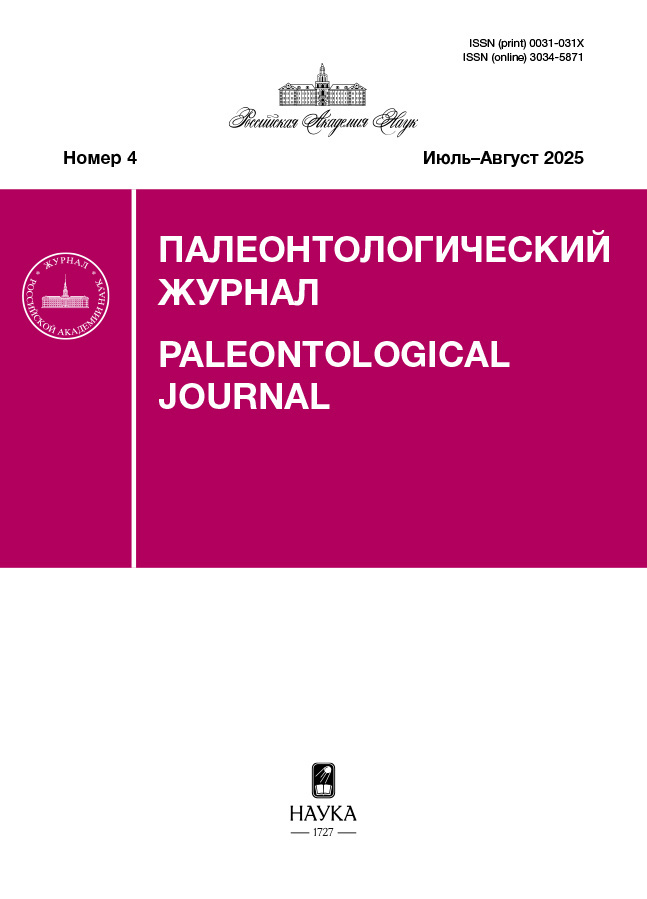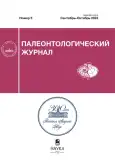On Taxonomic Affinity of Davletkulia gigantea Ivachnenko
- Authors: Bulanov V.V.1
-
Affiliations:
- Borissiak Paleontological Institute, Russian Academy of Sciences
- Issue: No 5 (2024)
- Pages: 105-113
- Section: Articles
- URL: https://journals.eco-vector.com/0031-031X/article/view/684740
- DOI: https://doi.org/10.31857/S0031031X24050119
- EDN: https://elibrary.ru/QUOYRY
- ID: 684740
Cite item
Abstract
The holotype (an isolated tooth) of the largest-known member of the family Bolosauridae, Davletkulia gigantea Ivachnenko, 1990, of middle Permian Yaman-Yushatyr’ locality, Orenburg Region, Russia, is reassigned to the herbivorous dinocephalians of the superfamily Tapinocephaloidea. This attribution is supported by the shape of tooth crown, patterns of wear and resorption, as well as the absence of reparative (tertiary) dentine inside the pulp cavity at the late stage of tooth functioning. The morphology of the holotype reveals the validity of D. gigantea which thus is the third representative of the group after Ulemosaurus svijagensis and U. gigas which was described from Eastern Europe, and, judging by the Otcher age of type locality, the oldest-known tapinocephaloid of the regional tetrapod assemblages.
Keywords
Full Text
About the authors
V. V. Bulanov
Borissiak Paleontological Institute, Russian Academy of Sciences
Author for correspondence.
Email: bulanov@paleo.ru
Russian Federation, Moscow, 117647
References
- Голубев В.К. Пермские и триасовые хрониозухии и биостратиграфия верхнетатарских отложений Восточной Европы по тетраподам. М.: Наука, 2000. 174 с. (Тр. Палеонтол. ин-та РАН. Т. 276).
- Ивахненко М.Ф. Новые котилозавры Приуралья // Палеонтол. журн. 1973. № 2. С. 131–134.
- Ивахненко М.Ф. Раннепермские элементы фаунистических комплексов тетрапод Восточной Европы // Палеонтол. журн. 1990. № 2. С. 102–111.
- Ивахненко М.Ф., Голубев В.К., Губин Ю.М. и др. Пермские и триасовые тетраподы Восточной Европы. М.: ГЕОС, 1997. 216 с. (Тр. Палеонтол. ин-та РАН. Т. 268).
- Ивахненко М.Ф., Твердохлебова Г.И. Ревизия пермских болозавроморфов Восточной Европы // Палеонтол. журн. 1987. № 2. С. 98–106.
- Сенников А.Г. Ранние текодонты Восточной Европы. М.: Наука, 1995. 142 с. (Тр. Палеонтол. ин-та РАН. Т. 263).
- Сенников А.Г. Некоторые проблемы типологии сообществ наземных тетрапод // Эволюция биосферы и биоразнообразия. М.: Тов-во научн. изд. КМК, 2006. С. 359–372.
- Berman D.S., Sumida S.S., Henrici A.C. et al. The early Permian bolosaurid Eudibamus cursoris: earliest reptile to combine parasagittal stride and digitigrade posture during quadrupedal and bipedal locomotion // Front. Ecol. Evol. 2021. 18 p. https://doi.org/10.3389/fevo.2021.674173
- Beust T.B. Development of dentin sclerosis // J. Amer. Dent. Assoc. 1935. V. 22. № 7. P. 1186–1189.
- Bulanov V.V., Kovalenko E.S., MacDougall M.J. et al. Tooth replacement and reparative dentine formation in the middle Permian bolosaurids of European Russia // Hist. Biol. 2022. V. 35. № 5. P. 748–761. https://doi.org/10.1080/08912963.2022.2067752
- Cope E.D. Descriptions of the extinct Batrachia and Reptilia from the Permian formation of Texas // Proc. Amer. Phil. Soc. 1878. V. 17. № 101. P. 505–530.
- Fish E.W. Dead tracts in dentine // Proc. R. Soc. Med. 1928. V. 22. № 2. P. 227–235.
- LeBlanc A.R.H., Brink K.S., Whitney M.R. et al. Dental ontogeny in extinct synapsids reveals a complex evolutionary history of the mammalian tooth attachment system // Proc. R. Soc. Lond. Ser. B. 2018. V. 285: 20181792. http://dx.doi.org/10.1098/rspb.2018.1792
- Li J.L., Cheng Z.W. The first discovery of bolosaurs from Upper Permian of China // Vert. PalAsiat. 1995. V. 33. P. 17–23.
- Reisz R.R. Origin of dental occlusion in tetrapods: signal for terrestrial vertebrate evolution? // J. Exp. Zool. Ser. B. 2006. V. 306. P. 26–277.
- Reisz R.R., Barkas V., Scott D. A new Early Permian bolosaurid reptile from the Richards Spur Dolese Brothers Quarry, near Fort Sill, Oklahoma // J. Vertebr. Paleontol. 2002. V. 22. № 1. P. 23–28.
- Reisz R.R., Müller J., Tsuji L. et al. The cranial osteology of Belebey vegrandis (Parareptilia: Bolosauridae), from the Middle Permian of Russia, and its bearing on reptilian evolution // Zool. J. Linn. Soc. 2007. V. 151. P. 191–214.
- Sidor C.A., Angielczyk K.D., Smith R.H. et al. Tapinocephalids (Therapsida, Dinocephalia) from the Permian Madumabisa Mudstone Formation (Lower Karoo, Mid-Zambezi Basin) of Southern Zambia // J. Vertebr. Paleontol. 2014. V. 34. № 4. P. 980–986.
- Smith A.J., Cassidy N., Perry H. et al. Reactionary dentinogenesis // Int. J. Devel. Biol. 1995. V. 39. P. 273–280.
- Snyder A.J., LeBlanc A.R.H., Jun C. et al. Thecodont tooth attachment and replacement in bolosaurid parareptiles // PeerJ. 2020. https://doi.org/10.7717/peerj.9168
- Throckmorton G.S. The effect of wear on the cheek teeth and associated dental tissues of the lizard Uromastix aegyptius (Agamidae) // J. Morphol. 1979. V. 160. P. 195–208.
- Watson D.M.S. On Bolosaurus, and the origin and classification of reptiles // Bull. Mus. Comp. Zool. 1954. V. 111. № 9. P. 297–449.
- Whitney M.R., Sidor C.A. Histological and developmental insights into the herbivorous dentition of tapinocephalid therapsids // PlosOne. 2019. 21 p. https://doi.org/10.1371/journal.pone.0223860
Supplementary files














